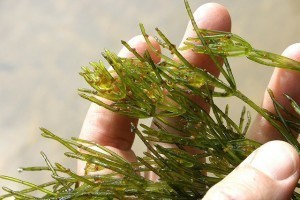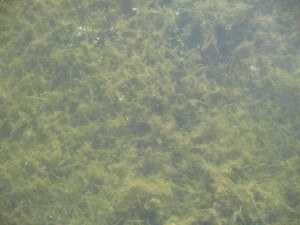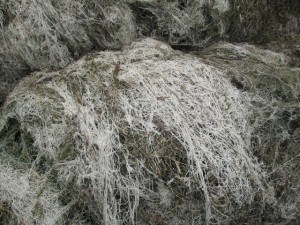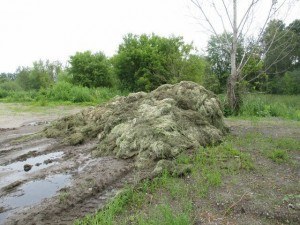Lake Scugog – The Impossible Appears to be Possible!
The story of a changed Lake Scugog
This year Eurasian watermilfoil, which has troubled our lake since the early 1970s with great expansion in the mid-2000s when it hybridized with the native Northern milfoil, is almost entirely gone. It has been replaced by alga called Chara, pronounced ‘cara’. This alga is not the usual soft, stringy green or brown stuff we have seen at our shorelines for years; rather it is a plant-like type because of its stem and leaf-like structures.
We first noticed a change in early June during our monitoring tour. No milfoil was visible. In fact the lake was extremely clear, with very little of anything showing at all. When we raked the bottom, however, up came a lot of Chara which we had seen some of the previous year. However, our monitoring tour on the 6th of J uly showed the new truth about the lake; there was almost no watermilfoil. All we could see was ‘wall to wall’ Chara –sometimes about a foot under the surface and sometimes much deeper. What a shake-up! The lake clarity was 8 to 10 ft. instead of the usual 4 to 6 ft. maximum. Calls and e-mails went out from us everywhere to try to figure it out.
uly showed the new truth about the lake; there was almost no watermilfoil. All we could see was ‘wall to wall’ Chara –sometimes about a foot under the surface and sometimes much deeper. What a shake-up! The lake clarity was 8 to 10 ft. instead of the usual 4 to 6 ft. maximum. Calls and e-mails went out from us everywhere to try to figure it out.
THE BIGGER PICTURE
Perhaps the most interesting call was to Dr. Eric Sager, a specialist in the ecology of the Kawartha Lakes who works out of both Trent University and Sir Sanford Fleming College. He laughed when he got our call as he is stumped too. He has no specific answers to the fact that there is virtually no Eurasian watermilfoil throughout all of the Kawartha Lakes, not just Lake Scugog. The Eurasian watermilfoil population has collapsed. He will be visiting Scugog to see conditions in the lake for himself and then he too will contribute to the ‘conversation.’
THIS SPECIES:
This native alga species, Chara likes hard water. It is sometimes is call muskgrass or skunkweed because of its foul, musty odour. Because it is coated with lime and also has tiny thorn-like projections on the branchlets, the plants are definitely rough and gritty to touch. It is not a plant. It has no flowers or leaves and does not extend above the water surface — generally growing about 2 ft off the bottom. Notice the small fruiting bodies in picture 1 that produce the spores for reproduction. Photo 2 shows the dense meadows it creates under the surface of the water. Although it technically does not have roots that feed the plant, it has anchors to the muck in the bottom with the thick alga mat floating above it.
because of its foul, musty odour. Because it is coated with lime and also has tiny thorn-like projections on the branchlets, the plants are definitely rough and gritty to touch. It is not a plant. It has no flowers or leaves and does not extend above the water surface — generally growing about 2 ft off the bottom. Notice the small fruiting bodies in picture 1 that produce the spores for reproduction. Photo 2 shows the dense meadows it creates under the surface of the water. Although it technically does not have roots that feed the plant, it has anchors to the muck in the bottom with the thick alga mat floating above it.
POSITIVES:
- Chara‘s attachment to the muddy bottom, with the dense mat a space above it, stabilizes the muck even in turbulent conditions therefore preventing the re-suspension of phosphorus and silt, thus clarifying the water in areas where it grows strongly.
- Chara locks phosphorus into itself and into the bottom substrate.
- Chara oxygenates the water as well as the muck at the bottom.
- Chara breaks down more slowly than milfoil or other vegetative matter so its decomposition over the winter should be less of a problem. It is suspected that it is evergreen and does not die in winter. However, this varies by type and we will be doing more research on that issue. If it does not decompose annually, its phosphorus locking mechanism is doubly useful.
- Chara is supposedly an important food source for waterfowl, particularly ducks. Bass and other panfish types eat it and graze on the life that it harbours. It provides valuable protection for young fish.
- Chara supports a healthy insect population in the lake bottom which helps feed the fish. It produces a strong food chain for many types of fish.

- Chara crowds out most bottom rooted plants, especially watermilfoil.
NEGATIVES:
- Because it grows so thickly it can really clog motors.
- Because it grows so thickly it is very hard to fish for whatever is under the layer of Chara unlike other vegetative weeds, even thick watermilfoil. The bed edges of thick watermilfoil beds edges provided excellent fishing areas for expert fishers.
- Because this is such a new phenomenon in our lake we have not been able to truly ascertain its negatives or possibly more positives other than that it has almost eliminated Eurasian watermilfoil – at least for this year.
INTERESTING INFO.:
When the Township harvested Port Perry Bay just after our monitoring session, they removed 10 tandem truck -loads of material. They were surprised at how much water just drained out of the brittle material and how little was left to finally dump. The harvested material seems to just be mainly crunchy strings when all the water drained out easily. See photo of the resulting small pile at the Township yard and then how it turns white quickly as it dries because of the high calcium content. It did contain a percentage of Canada waterweed as well.
just after our monitoring session, they removed 10 tandem truck -loads of material. They were surprised at how much water just drained out of the brittle material and how little was left to finally dump. The harvested material seems to just be mainly crunchy strings when all the water drained out easily. See photo of the resulting small pile at the Township yard and then how it turns white quickly as it dries because of the high calcium content. It did contain a percentage of Canada waterweed as well.
QUESTIONS THAT WE NEED TO ANSWER:
- What caused this collapse of the Eurasian watermilfoil population? Is it just the hybrid type milfoil or all milfoil? Why did the Chara come in?
- Is there a likelihood that that conditions will reverse in the near future or will the stabilization of the muck and the phosphorus into the Chara mat be long term? What are the new phosphorus levels in the water column, especially on the west side of the lake which appears to be most effected?
- Is there a connection with the enormous rain events we have had this spring? Because the east side of the lake is much bigger and deeper, does the percentage dilution from al
 l that new water in the lake have less effect on that side. It appears that the east side is much more ‘business as usual’. Why is that? Did early warm temperatures have anything to do with it? Ice conditions?
l that new water in the lake have less effect on that side. It appears that the east side is much more ‘business as usual’. Why is that? Did early warm temperatures have anything to do with it? Ice conditions? - Is there any way to get a better balance of types of water plants and algae? Is Chara truly a positive or a negative for lake health in general?
- Is Chara at this population level a positive or a negative for fish and animal life in the lake as reported, especially walleye.
- What variety of Chara do we have and is it evergreen?
- What is Chara’s connection with blue green algae and if there is a connection are they types that cause problems for swimmers?
And many more. Please send us your comments via scugoglakestewards@gmail.com
